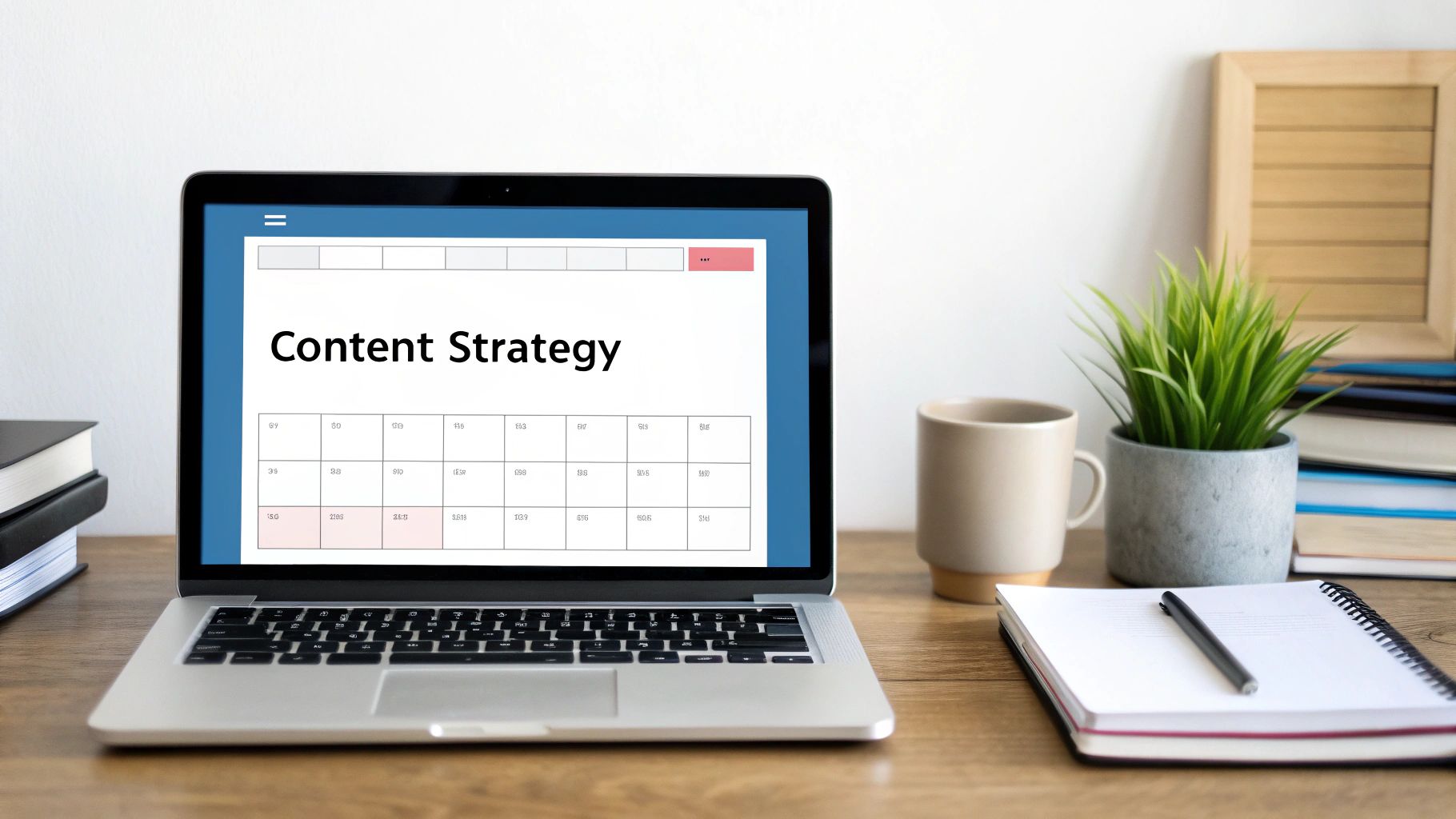In today's competitive market, simply "doing" digital marketing isn't enough to drive significant growth. Success requires a strategic, disciplined approach built on a foundation of proven principles. Generic tactics yield generic results; real progress comes from implementing specific, actionable strategies that are both effective and scalable. This guide is designed to move you beyond the basics, offering a comprehensive roundup of the essential digital marketing best practices you need to master.
We've distilled complex concepts into a clear, straightforward listicle format. You won't find vague theories or surface-level advice here. Instead, you'll get a detailed rundown of critical areas, including everything from a sophisticated content marketing strategy and advanced search engine optimization (SEO) to the nuances of email marketing automation and data-driven decision-making. We will explore each practice with practical implementation details and real-world examples to help you apply these concepts directly to your own campaigns.
Think of this article as your roadmap for building a high-performance marketing engine. We will cover ten key pillars:
- Content Marketing Strategy
- Search Engine Optimization (SEO)
- Social Media Marketing
- Email Marketing Automation
- Data-Driven Decision Making
- Customer Experience (CX) Optimization
- Mobile-First Strategy
- Marketing Automation
- Influencer Marketing
- Conversion Rate Optimization (CRO)
Whether you are part of a sales team aiming to generate better leads, an email marketer looking to improve deliverability, or a startup founder building a strategy from scratch, these insights will equip you to attract, engage, and convert your audience more effectively. Let's dive into the practices that separate the good from the great.
1. Content Marketing Strategy
A strong content marketing strategy is the foundation of many modern digital marketing best practices. It moves beyond simple advertising by focusing on creating and distributing valuable, relevant, and consistent content to attract, engage, and retain a specific audience. The ultimate goal is to build trust and authority, which in turn drives profitable customer action.
Instead of directly pitching your products or services, you provide genuinely useful content that solves your audience's problems. This approach positions your brand as a helpful expert and a reliable resource. A well-executed strategy not inly attracts organic traffic but also nurtures potential customers through their buying journey, making them more likely to choose you when they are ready to make a purchase.

How to Implement a Content Marketing Strategy
Successful content marketing requires a clear plan. It starts with understanding who you are talking to and what they need.
- Develop Buyer Personas: Before writing a single word, create detailed profiles of your ideal customers. Understand their pain points, goals, and where they look for information. This ensures your content is always relevant.
- Identify Core Topics: Use data from keyword research tools and industry trend analysis to find topics your audience is actively searching for. Focus on subjects where you can offer a unique perspective or deeper insights.
- Create a Content Calendar: Plan your content creation and distribution in advance. This helps maintain consistency in your publishing schedule and ensures a steady flow of fresh material across all your channels.
Key Insight: The best content marketing doesn't feel like marketing at all. It educates, entertains, or inspires, building a relationship with the audience long before a transaction ever occurs.
Examples of Success
Companies like HubSpot have built their entire marketing model around providing exceptional content, from their blog to their free resource library, generating millions of visitors each month. Similarly, Mailchimp offers extensive educational guides that help small businesses succeed, cementing their status as a trusted advisor in the email marketing space. To truly succeed, content must combine engaging narratives with strong SEO copywriting best practices, ensuring both visibility and reader engagement.
2. Search Engine Optimization (SEO)
Search Engine Optimization (SEO) is the practice of increasing the quantity and quality of traffic to your website through organic search engine results. It involves making strategic changes to your website design and content to make your site more attractive to search engines. Good SEO positions your brand as a credible answer to a user's query, driving highly relevant traffic without paying for ads.
This practice is fundamental to long-term digital marketing success. By optimizing your online presence, you improve visibility in search engine results pages (SERPs), making it easier for potential customers to find you when they are actively looking for solutions you provide. A solid SEO strategy ensures you are not just visible but are also seen as an authoritative and trustworthy source in your industry.

How to Implement SEO
Effective SEO is a multi-faceted discipline that combines technical, on-page, and off-page efforts. It begins with understanding what your audience is searching for and how search engines work.
- Focus on Search Intent: Move beyond simple keywords to understand the why behind a search. Is the user looking to buy, learn, or find a specific website? Align your content with this intent.
- Optimize Core Web Vitals: Ensure your website provides a great user experience by focusing on loading speed, interactivity, and visual stability. Search engines prioritize sites that are fast and easy to use.
- Build Topic Clusters: Create a central "pillar" page for a broad topic and link out to more detailed "cluster" pages on related subtopics. This structure signals your expertise to search engines.
- Acquire High-Quality Backlinks: Earn links from reputable, relevant websites in your industry. Backlinks act as a vote of confidence, significantly boosting your site's authority.
Key Insight: Great SEO is not about tricking search engines; it's about providing an exceptional user experience and valuable content that naturally earns high rankings over time.
Examples of Success
Companies like Airbnb dominate travel-related searches by creating highly optimized landing pages for specific locations, capturing users with strong local intent. E-commerce giant Zappos excels at on-page SEO, with detailed product pages that rank for thousands of long-tail keywords. Another key player, Moz, practices what it preaches by ranking for competitive SEO-related terms, using its own blog and tools to drive organic growth. These examples show how a deep understanding of SEO is one of the most powerful digital marketing best practices.
3. Social Media Marketing
Effective social media marketing involves more than just posting updates; it's about building a community and fostering genuine connections. This practice uses platforms like Instagram, Twitter, and LinkedIn to connect with your audience, build brand awareness, and drive meaningful actions like website traffic or sales. The core idea is to meet your customers where they spend their time and engage with them authentically.
By creating and sharing content tailored to each platform, you can participate in relevant conversations and showcase your brand's personality. A well-managed social media presence makes your brand more relatable and accessible, humanizing your business and building lasting loyalty. It's a powerful tool for both customer acquisition and retention when executed thoughtfully.

How to Implement Social Media Marketing
A strategic approach is essential for turning social media activity into tangible business results. It begins with understanding your audience's behavior on different platforms.
- Choose the Right Platforms: Don’t try to be everywhere. Focus on the channels where your target audience is most active. A B2B tech company might prioritize LinkedIn, while a visual-heavy fashion brand would focus on Instagram and TikTok.
- Create Platform-Specific Content: Tailor your content to fit the format and user expectations of each platform. Use platform-native features like Instagram Reels, TikTok videos, or LinkedIn articles to maximize engagement and reach.
- Engage Authentically: Social media is a two-way conversation. Respond to comments, answer questions, and participate in relevant discussions. Show your audience that there are real people behind the brand.
Key Insight: The goal of social media isn't to collect followers, but to build a loyal community. Focus on engagement metrics like comments, shares, and saves over vanity metrics like follower count.
Examples of Success
Companies like Wendy's have mastered this by using witty and humorous engagement on Twitter to build a distinct brand personality that resonates with millions. Beauty brand Glossier built an empire by leveraging Instagram, turning user-generated content and community feedback into the core of its marketing strategy. For B2B, LinkedIn itself is a prime example, with professionals using its platform to establish thought leadership and drive business connections. These examples prove that a strong social media strategy is a key component of modern digital marketing best practices.
4. Email Marketing Automation
Email marketing automation uses software to send the right message to the right people at the right time, without manual effort for every campaign. It involves setting up behavioral triggers, segmented lists, and personalized messages to nurture leads, onboard new customers, and maintain relationships at scale. This practice is a cornerstone of modern digital marketing best practices because it delivers highly relevant content automatically.
By leveraging automation, marketers can create complex, personalized customer journeys that respond to user actions in real-time. Whether a user abandons a shopping cart, downloads a resource, or has been inactive for a while, an automated email sequence can re-engage them with a targeted message. This approach ensures timely communication, improves efficiency, and significantly boosts conversion rates.

How to Implement Email Marketing Automation
Effective automation is built on a foundation of data and strategy. It goes beyond simple "set it and forget it" campaigns to create dynamic, responsive communication flows.
- Segment Your Audience: Group subscribers based on their behavior, purchase history, demographics, or engagement level. This allows you to send highly targeted campaigns that resonate with specific subsets of your audience.
- Establish Behavioral Triggers: Set up automated workflows that are initiated by specific user actions. Common triggers include signing up for a newsletter (welcome sequence), making a purchase (post-purchase follow-up), or visiting a specific page (interest-based content).
- Balance Promotional and Educational Content: Create email sequences that provide value beyond just sales pitches. Mix in helpful tips, educational resources, and company news to build a stronger relationship and keep your subscribers engaged.
Key Insight: The power of automation isn't just sending emails automatically; it's about creating personalized conversations at scale, making each subscriber feel like they are receiving a message crafted just for them.
Examples of Success
Companies like Dropbox use a simple yet powerful onboarding email sequence to guide new users through their product features, increasing adoption and long-term retention. Airbnb sends automated, personalized travel recommendations based on a user's search history, encouraging them to book their next trip. Success depends on selecting the right tools, and you can explore an email marketing platform comparison to find the best fit for your automation needs.
5. Data-Driven Decision Making
Data-driven decision making is a core component of modern digital marketing best practices. It involves shifting away from guesswork and intuition, instead using analytics, metrics, and data insights to guide marketing strategies and tactical decisions. This practice requires collecting, analyzing, and interpreting data from various digital touchpoints to optimize campaigns, allocate budgets effectively, and improve overall ROI.
By grounding your choices in concrete evidence, you can understand what resonates with your audience, which channels perform best, and how to refine your approach for maximum impact. This strategic process turns marketing into a science, enabling continuous improvement and ensuring that every action is purposeful and measurable. It empowers marketers to justify their strategies with tangible results and adapt quickly to changing market dynamics.
How to Implement Data-Driven Decision Making
A successful data-driven approach requires a systematic process for gathering, analyzing, and acting on information. It starts with establishing clear goals and the right tools to measure progress.
- Set Up Proper Tracking: Before launching any campaign, ensure tools like Google Analytics, CRM software, and social media analytics are correctly configured. Use UTM parameters to track the performance of specific links and channels.
- Focus on Actionable Metrics: Avoid "vanity metrics" like raw page views or follower counts. Instead, concentrate on metrics that directly impact business goals, such as conversion rates, customer acquisition cost (CAC), and customer lifetime value (LTV).
- Create Automated Reports: Use dashboards and automated reporting tools to monitor key performance indicators (KPIs) regularly. This provides consistent, up-to-date insights without manual effort, allowing your team to focus on strategy rather than data pulling. For this, explore various data quality management tools.
Key Insight: Data doesn't just tell you what happened; it tells you why it happened. The goal is to move beyond simply reporting numbers to understanding the user behaviors and market trends behind them.
Examples of Success
Companies like Netflix have mastered data-driven marketing. Its powerful recommendation algorithm, which is responsible for driving over 80% of viewer activity, analyzes viewing habits to personalize content suggestions. Similarly, Amazon uses customer data to power its dynamic pricing engine and personalized product recommendations, significantly boosting sales and customer loyalty. These examples show how data transforms the customer experience and drives business growth.
6. Customer Experience (CX) Optimization
Exceptional Customer Experience (CX) is a critical component of modern digital marketing best practices. It goes beyond customer service by focusing on designing and optimizing every digital touchpoint to create seamless, enjoyable, and valuable interactions throughout the entire customer journey. The primary goal is to foster loyalty and advocacy by exceeding customer expectations at every turn.
Instead of viewing interactions as isolated events, CX optimization treats the entire relationship as a single, continuous experience. This approach positions your brand as one that understands and values its customers, which directly impacts retention and lifetime value. A well-designed CX strategy not only delights customers but also creates a powerful competitive differentiator that is difficult for others to replicate.
How to Implement Customer Experience (CX) Optimization
Effective CX optimization requires a deep understanding of your audience and a commitment to continuous improvement. It begins with listening to your customers and mapping their interactions with your brand.
- Map the Customer Journey: Document every touchpoint a customer has with your brand, from initial awareness to post-purchase support. Identifying pain points and moments of delight is essential for targeted improvements.
- Utilize Customer Feedback: Actively collect and analyze feedback from surveys, reviews, and support tickets. Use these insights to identify opportunities for enhancement and address frustrations before they escalate.
- Personalize Interactions: Leverage customer data to deliver personalized content, recommendations, and offers. This shows customers you understand their individual needs and preferences, making their experience feel more relevant and valued. To effectively enhance user satisfaction and conversion, it's essential to map and improve every touchpoint along the customer journey, as detailed in this A Guide to Customer Journey Optimization.
Key Insight: The best customer experience is invisible. It works so seamlessly that the customer doesn't notice the effort behind it, they just feel understood and appreciated.
Examples of Success
Companies like Zappos built their reputation on legendary customer service and a hassle-free returns policy, creating a deeply loyal customer base. Similarly, Apple delivers a consistent and intuitive experience across its hardware, software, and retail stores, setting the industry standard for user-centric design. Building these strong bonds requires a solid foundation in managing client interactions, so understanding customer relationship management basics is a crucial first step for any business.
7. Mobile-First Strategy
A mobile-first strategy is an approach to design and development that prioritizes the mobile user experience. Instead of designing for a large desktop screen and then scaling it down, this practice starts with the smallest screen first and then works its way up to larger devices. This acknowledges the reality that the majority of internet traffic and customer interactions now happen on smartphones.
By focusing on the mobile experience from the outset, you ensure your marketing efforts are optimized for the platform your audience uses most. This leads to faster load times, easier navigation, and a more intuitive user journey, which are critical for engagement and conversion. This approach is a core component of modern digital marketing best practices, as it directly impacts user satisfaction, search engine rankings, and ultimately, your bottom line.
How to Implement a Mobile-First Strategy
Adopting a mobile-first mindset requires a strategic shift in how you plan and execute campaigns. It starts with understanding the unique constraints and opportunities of the mobile environment.
- Design for Thumbs: Create layouts with thumb-friendly navigation. Place key calls-to-action and interactive elements in easily accessible zones on the screen, minimizing the need for users to stretch or zoom.
- Optimize for Speed: Mobile users expect speed. Use tools like Accelerated Mobile Pages (AMP) to create lightweight, fast-loading versions of your landing pages. Compress images and streamline code to reduce load times.
- Simplify Forms and Inputs: Make it easy for users to provide information. Design short, simple forms with large input fields, and leverage mobile features like auto-fill and numeric keypads for relevant fields like phone numbers.
Key Insight: Mobile-first is not just about responsive design; it's a content strategy. It forces you to prioritize what's most important, ensuring your core message is clear and compelling on every device.
Examples of Success
Companies like Starbucks have mastered this strategy with their mobile app, which now drives over 25% of their U.S. transactions by offering seamless ordering and payment. Instagram built its entire platform around the vertical mobile experience, with features like Stories perfectly optimized for smartphone viewing. These examples show how prioritizing mobile enhances convenience and creates deeply engaging user experiences that boost business growth.
8. Marketing Automation
Marketing automation involves using software to streamline, automate, and measure marketing tasks and workflows. It moves beyond manual processes by enabling businesses to nurture leads, segment audiences, and deliver personalized experiences at scale. The primary goal is to increase operational efficiency and grow revenue faster.
Instead of sending generic messages to an entire list, automation allows you to send targeted communications based on user behavior, preferences, or lifecycle stage. This approach ensures that the right message reaches the right person at the right time. A well-implemented marketing automation strategy not only saves valuable time but also enhances the customer journey, guiding prospects from initial awareness to loyal advocacy.
How to Implement Marketing Automation
Successful automation requires a strategic plan focused on the customer journey. It begins with identifying key touchpoints and triggers for communication.
- Map Customer Journeys: Outline the typical paths your customers take from discovery to purchase. Identify key actions like downloading an ebook, signing up for a webinar, or visiting a pricing page that can trigger automated workflows.
- Start with Simple Workflows: Begin with straightforward automations, such as a welcome email series for new subscribers or a lead nurturing sequence for inbound inquiries. This allows you to test and learn before building more complex systems.
- Ensure Data Quality: Your automation is only as good as your data. Regularly clean your contact database to remove duplicates, correct errors, and ensure all information is up-to-date for effective segmentation and personalization.
Key Insight: Effective marketing automation doesn't replace the human touch; it enhances it. It frees up marketers to focus on strategy and creativity while handling the repetitive, data-driven tasks.
Examples of Success
Companies like HubSpot have championed the use of automation to power their inbound marketing model, nurturing leads through sophisticated email workflows and personalized content delivery. Similarly, Salesforce’s Pardot excels in B2B environments, helping businesses automate lead scoring and assignment to streamline the sales process. The most effective digital marketing best practices often combine powerful automation with a deep understanding of customer needs, creating a seamless and responsive experience.
9. Influencer Marketing
Influencer marketing is a powerful strategy that involves partnering with individuals who have established credibility and a dedicated audience in a specific niche. This approach leverages the trust and relationship an influencer has built with their followers to promote products or services, driving brand awareness, engagement, and sales. It moves marketing from a direct brand-to-consumer message to a more authentic, peer-to-peer recommendation.
Instead of your brand talking about itself, a trusted voice in the community does it for you. This creates a powerful form of social proof, as recommendations from influencers are often perceived as more genuine than traditional advertising. A well-executed influencer campaign can introduce your brand to a highly targeted and engaged audience, building credibility and driving conversions far more effectively than a standard ad.
How to Implement Influencer Marketing
Successful influencer marketing goes beyond paying for a single sponsored post. It requires strategic planning to find the right partners and build authentic campaigns.
- Prioritize Authenticity and Alignment: Look for influencers whose personal brand, values, and audience demographics align perfectly with your own. A smaller, highly engaged audience with the right fit is more valuable than a massive, generic one.
- Focus on Engagement Over Follower Count: High follower counts can be misleading due to bots or inactive users. Analyze an influencer's engagement rate (likes, comments, shares) to gauge the true connection they have with their audience.
- Establish Clear Goals and Tracking: Define what you want to achieve, whether it's brand awareness, lead generation, or sales. Use unique tracking links, promo codes, and UTM parameters to accurately measure the ROI of each campaign.
- Build Long-Term Relationships: Treat influencers as long-term brand partners rather than one-off transaction. Nurturing these relationships leads to more authentic content and greater value over time.
Key Insight: The most effective influencer marketing campaigns grant creative freedom. Let influencers communicate in their own voice to maintain the authenticity their audience expects and trusts.
Examples of Success
Companies like Gymshark built their empire by forging strong, long-term partnerships with fitness influencers, turning them into dedicated brand ambassadors who authentically live the brand's lifestyle. Similarly, watch brand Daniel Wellington scaled almost exclusively through a massive Instagram influencer strategy, sending its products to a wide range of creators. Glossier also mastered this by leveraging a community of micro-influencers and everyday customers, making their community a core part of their marketing efforts. This strategy is a key component of modern digital marketing best practices that generate genuine brand loyalty.
10. Conversion Rate Optimization (CRO)
Conversion Rate Optimization (CRO) is a systematic process of increasing the percentage of website visitors who take a desired action. This practice moves beyond simply attracting traffic and focuses on maximizing the value of the visitors you already have, whether the goal is making a purchase, signing up for a newsletter, or filling out a form.
Instead of guessing what might work, CRO uses data, analytics, and user feedback to make informed decisions. By analyzing user behavior and testing changes to page elements like headlines, calls-to-action (CTAs), and layout, you can significantly improve performance. A well-executed CRO strategy is one of the most effective digital marketing best practices for boosting ROI because it enhances the efficiency of all your other marketing efforts.
How to Implement Conversion Rate Optimization
Effective CRO is a continuous cycle of analysis, hypothesis, testing, and learning. It begins with understanding how users interact with your site and identifying areas of friction.
- Analyze High-Impact Pages: Start with your highest-traffic pages, like the homepage or landing pages, where small improvements can yield significant results. Use tools like Google Analytics to identify pages with high bounce rates or low conversion rates.
- Use Heatmaps and User Recordings: Visually understand how users interact with your pages. Heatmaps show where users click and scroll, helping you identify which elements are getting attention and which are being ignored.
- Test One Element at a Time: To get clear, reliable data, conduct A/B tests where you change only a single variable, such as the button color, headline text, or image. This ensures you know exactly what caused any change in performance.
Key Insight: CRO is not about manipulating users with design tricks. It's about understanding their needs and removing obstacles to help them achieve their goals on your website more easily.
Examples of Success
Companies like Amazon have mastered CRO, famously implementing one-click purchasing to eliminate friction in the checkout process and dramatically increase sales. Dropbox achieved explosive growth by using a minimalist homepage with a single, clear call-to-action focused on signing up, reducing distractions and boosting conversions. You can discover more strategies with these conversion rate optimization tips, which provide actionable ways to improve user experience and drive results.
Best Practices Comparison of 10 Digital Marketing Strategies
| Marketing Approach | Implementation Complexity | Resource Requirements | Expected Outcomes | Ideal Use Cases | Key Advantages |
|---|---|---|---|---|---|
| Content Marketing Strategy | Moderate (requires planning and consistent creation) | Time-intensive content creation, SEO skills | Builds brand authority, improves organic traffic, generates qualified leads | Long-term brand building, inbound lead generation | Cost-effective, lasting digital assets |
| Search Engine Optimization (SEO) | Moderate to High (technical and ongoing) | SEO expertise, technical resources, link building | Higher organic rankings, increased quality traffic | Website visibility, competitive niches | Cost-effective, measurable ROI, passive leads |
| Social Media Marketing | Moderate to High (continuous content & engagement) | Content creation, community management | Brand awareness, direct audience engagement, viral reach | Customer interaction, brand engagement | Precise targeting, real-time feedback |
| Email Marketing Automation | High (complex setup and segmentation) | Automation tools, data management, CRM integration | High ROI, personalized lead nurturing | Lead nurturing, customer retention | Scalable personalization, direct communication |
| Data-Driven Decision Making | High (requires analytics expertise) | Advanced analytics tools, data governance | Improved ROI, optimized campaigns, quick pivots | Campaign optimization, strategic planning | Removes guesswork, accountability |
| Customer Experience Optimization | High (cross-functional, tech intensive) | UX design, personalization engines, feedback systems | Increased customer satisfaction, loyalty, improved conversions | End-to-end customer journey enhancement | Competitive differentiation, loyalty |
| Mobile-First Strategy | Moderate to High (development focused) | Mobile design/development, app optimization | Better mobile engagement, improved rankings, increased conversions | Mobile user engagement, app-centric business | Reaches majority mobile users, location targeting |
| Marketing Automation | High (complex workflows) | Automation software, data integration | Efficient lead nurturing, scalable personalization | Lead management, multi-channel campaigns | Reduces manual tasks, improves lead quality |
| Influencer Marketing | Moderate (partner management needed) | Influencer partnerships, content coordination | Brand awareness, authentic content, niche audience reach | Brand awareness, social proof | Trust leveraging, cost-effective compared to ads |
| Conversion Rate Optimization (CRO) | Moderate to High (requires testing and analysis) | Testing tools, analytics, sufficient traffic | Increased conversion rates, better ROI without extra traffic | E-commerce, lead generation optimization | Maximizes value from existing traffic |
From Insight to Action: Integrating Your Marketing Strategy
Navigating the landscape of modern marketing can feel like juggling a dozen moving parts. We've explored the essential pillars, from building a robust Content Marketing Strategy and mastering Search Engine Optimization (SEO) to engaging audiences through Social Media and streamlining workflows with Marketing Automation. Each of these areas represents a powerful lever for growth. However, the true magic happens not when you master them in isolation, but when you weave them together into a single, cohesive strategy. The most effective digital marketing best practices are not a checklist to be completed; they are interconnected components of a dynamic engine.
Think of it this way: your SEO efforts attract new visitors, but it's your Customer Experience (CX) Optimization that convinces them to stay. Your data-driven insights inform your email campaigns, while your Conversion Rate Optimization (CRO) ensures those campaigns translate into tangible results. This synergy is where sustainable growth is born. A brilliant social media campaign falls flat if it leads to a clunky, non-mobile-friendly website. Likewise, a sophisticated automation sequence is useless if your core email list is plagued by invalid contacts, high bounce rates, and spam traps.
Your Actionable Roadmap Forward
To prevent feeling overwhelmed, focus on incremental, strategic implementation. Don't try to revolutionize everything overnight. Instead, use the insights from this article to build momentum.
Here are your next steps:
- Conduct a Comprehensive Audit: Start by evaluating your current efforts against the ten practices we've discussed. Where are your biggest strengths? More importantly, where are the most significant gaps or opportunities for improvement? Use analytics to guide this assessment.
- Prioritize for Impact: You can't fix everything at once. Identify the one or two areas that will have the most immediate and substantial impact on your goals. Is your mobile experience lagging? Start there. Is your email deliverability suffering? Make data hygiene your top priority.
- Focus on Integration Points: Look for opportunities to connect your strategies. For example, how can you repurpose content from your blog (Content Marketing) for your social media channels and email newsletters? How can you use data from your CRO tests to inform your next SEO keyword strategy?
- Commit to Data Quality: Before scaling any outreach, especially for B2B audiences, solidify your data foundation. This is a critical, non-negotiable step. Ensuring your contact lists are clean and verified protects your sender reputation, improves campaign ROI, and makes personalization possible. Neglecting this is like building a skyscraper on a foundation of sand.
The True Value of Mastering Digital Marketing
Ultimately, embracing these digital marketing best practices is about more than just boosting metrics. It's about building a resilient, customer-centric business that can adapt to the ever-changing digital environment. It’s about creating meaningful connections with your audience, understanding their needs, and delivering value at every single touchpoint. By moving from isolated tactics to an integrated, data-informed strategy, you are not just marketing smarter; you are building a powerful competitive advantage.
The journey to marketing excellence is ongoing. It requires curiosity, a commitment to testing, and a willingness to adapt. The principles we've covered provide the blueprint. Now, it's your turn to take these insights, apply them to your unique business, and start building the powerful marketing engine that will drive your growth for years to come.

